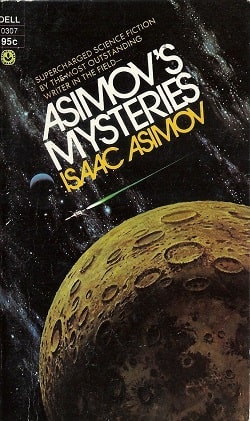Summary

Asimov's Mysteries
by Isaac Asimov
13 INCREDIBLE TALES BY THE INCOMPARABLE MASTER OF SCIENCE FICTION:
THE SINGING BELL—An intergalactic criminal steals treasured, musical lunar artifacts.
THE TALKING STONE—A spaceship crew is planning on some illegal uranium mining with the help of on intelligent creature mode of rock.
WHAT'S IN A NAME?—Everything. Especially when twin librarians ore involved in a murder.
PÂTÉ DE FOIE GRAS—Just how did that goose lay the golden egg?
Also included in the collection are: THE DYING NIGHT. THE DUST OF DEATH, A LOINT OF PAW, I'M IN MARSPORT WITHOUT HILDA, MAROONED OFF VESTA and ANNIVERSARY, OBITUARY, STAR LIGHT, THE KEY, and THE BILLIARD BALL.
.
Read
Asimov's Mysteries on http://kissnovel.net
Martial Peak Reviews
Isaac Asimov's Asimov's Mysteries is a captivating collection of short stories that showcases the author's unparalleled ability to blend science fiction with elements of mystery. Published in 1968, this anthology features thirteen tales that not only entertain but also provoke thought, making it a must-read for fans of both genres. Asimov, known primarily for his groundbreaking work in science fiction, demonstrates here that he is equally adept at crafting intricate plots filled with suspense and intrigue.
The collection opens with "The Singing Bell," a story that sets the tone for the anthology. In this tale, an intergalactic criminal steals treasured musical artifacts from the moon, leading to a thrilling chase that highlights Asimov's knack for world-building. The lunar setting is vividly described, and the musical artifacts serve as a metaphor for the beauty and fragility of culture, a recurring theme throughout the collection. Asimov's ability to weave complex narratives with rich settings is evident here, as he immerses readers in a universe where art and crime collide.
Another standout story is "The Talking Stone," which introduces readers to a spaceship crew planning illegal uranium mining with the help of an intelligent rock creature. This narrative not only explores the ethical implications of exploitation but also raises questions about intelligence and consciousness. Asimov's portrayal of the rock as a sentient being challenges traditional notions of life and intelligence, pushing readers to reconsider what it means to be 'alive.' This theme of consciousness is echoed in other stories, such as "What's in a Name?" where twin librarians become embroiled in a murder mystery that hinges on identity and perception.
Character development is a strong suit in Asimov's Mysteries. Each story features well-rounded characters who are often faced with moral dilemmas or existential questions. In "Pâté de Foie Gras," for instance, the protagonist grapples with the consequences of greed and ambition, ultimately leading to a profound realization about the nature of happiness. Asimov's characters are not merely vessels for the plot; they are complex individuals whose journeys resonate with readers on a personal level.
Asimov's writing style is both accessible and engaging, making the stories easy to digest while still offering depth. His use of dialogue is particularly effective, often revealing character motivations and advancing the plot in a natural way. The pacing of the stories varies, with some unfolding rapidly while others take a more contemplative approach. This variety keeps readers engaged and encourages them to reflect on the themes presented.
The anthology also includes stories like "The Dying Night" and "The Dust of Death," which delve into the darker aspects of human nature and the consequences of our actions. These tales serve as cautionary narratives, warning against the dangers of hubris and the ethical implications of scientific advancement. Asimov's ability to intertwine moral lessons with entertaining plots is a hallmark of his writing, and it is particularly evident in this collection.
One of the most intriguing aspects of Asimov's Mysteries is its exploration of the intersection between science fiction and mystery. Asimov masterfully blends these genres, creating stories that are not only thrilling but also intellectually stimulating. This fusion is reminiscent of the works of Arthur Conan Doyle, who famously combined elements of mystery and deduction in his Sherlock Holmes stories. However, Asimov's approach is distinct, as he incorporates futuristic technology and speculative concepts that challenge readers to think beyond the confines of traditional mystery narratives.
Asimov's influence on the science fiction genre cannot be overstated, and Asimov's Mysteries serves as a testament to his versatility as a writer. The stories in this collection are not just entertaining; they are thought-provoking explorations of human nature, ethics, and the complexities of existence. Asimov's ability to tackle profound themes within the framework of engaging narratives sets him apart from many of his contemporaries.
In conclusion, Asimov's Mysteries is a remarkable collection that showcases Isaac Asimov's talent for blending science fiction with mystery. The stories are rich in character development, thematic depth, and imaginative world-building. Asimov's exploration of consciousness, morality, and the human condition resonates throughout the anthology, making it a compelling read for anyone interested in the interplay between these genres. Whether you are a long-time fan of Asimov or a newcomer to his work, this collection is sure to leave a lasting impression.
























Reviews 0
Post a Reviews: